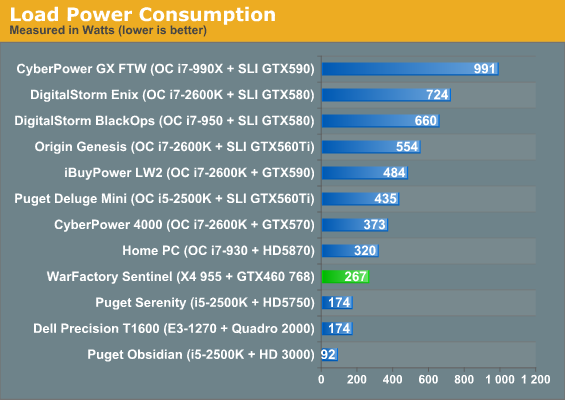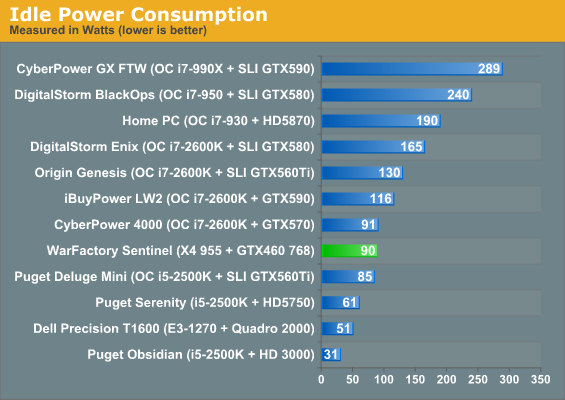WarFactory Sentinel: Gaming on a Grand
by Dustin Sklavos on June 8, 2011 12:01 AM ESTBuild, Noise, Heat, and Power Consumption
Keeping in line with the WarFactory Sentinel's "balanced budget" aspirations, cooling is handled by the custom cooler on the ASUS GeForce GTX 460 768MB TOP (phew), AMD's stock cooler for the Phenom II, and the two 120mm fans the CoolerMaster HAF 912 ships with. Since none of the components are particularly power hungry (as you'll see below), none of the fans have to work too hard, and the result is a reprieve from the noisy gaming systems I've been testing of late.
It's the balance that I really appreciate with WarFactory's component choices in the Sentinel. There's no shame in wanting to build a "sky's the limit" performance machine, but I think there's really an art to building within a budget. When I'm building a machine for friends or family, I live for that, so a system like the Sentinel that really hits the sweet spot and includes a lot of the same component choices I might have made is appreciated. The only questionable decision I feel like they made was the use of G.Skill instead of a more reputable brand like Kingston or Corsair or Crucial, but WarFactory is willing to back it up with a lifetime warranty and RAM is at the commodity item level where differences usually only matter for overclockers.

When we're talking about budget, it's important to see just how much it would cost to build the system yourself, and in that situation (assuming no shipping or sales tax) you're basically paying about $200 for WarFactory to build it for you. To me that seems fairly reasonable; the company is still cutting a profit but not an obscene one, and you're basically paying for a lifetime service plan for the computer. Compare that to paying $300 to Best Buy for one of their insane extended warranties and it seems like a much better deal.

At this point the proof is really in the pudding, so to speak. The thermals for the Sentinel are frankly outstanding; even the graphics card isn't hitting 60C. It's a welcome change of pace, especially when you realize the Sentinel runs very quietly. Outside of the Puget Systems builds and the Dell Precision, this is the quietest desktop I've tested and would be a fine choice for anyone who needs a powerful computer on a budget and doesn't want to have to worry about a jet turbine in their bedroom or office.


While AMD's chips do tend to be less power efficient than Intel's, it's basically a wash in power consumption. The Sentinel's idle consumption is still perfectly reasonable, while load consumption ranks among the lowest (thanks to the use of a single moderate GPU and lack of overclocking). Once you factor a decent video card into the equation, most of Intel's power savings evaporate.
















37 Comments
View All Comments
TrackSmart - Thursday, June 9, 2011 - link
Yes, but the Dell would come with a 250 Watt no-name powersupply and the world's worst $20-equivalent case. And if you care about gaming, the graphics card is a bigger bottleneck than the CPU, so the 5770 would make the system about 20% slower for gaming (my rough guess). And the SSD, though tiny, will make all normal computing tasks much snappier, even if it is too small for games. And it comes with a lifetime warranty. How much would Dell charge if you wanted even a 3 year warranty?In sum, I'd still take this over the Dell any day (assuming I had to buy pre-built)
frozentundra123456 - Thursday, June 9, 2011 - link
I know the power supply is more than 250 watts. Dont be ridiculous. In fact I think they upgraded it to around 430 watts. Any you may be right that a SSD makes the computer faster in day to day use. But to me this is a PC that is supposed to get maximum gaming performance per dollar. I dont think an SSD fits into that build.And I still dont think it makes any sense to buy a gaming PC with an old tech processor that has been outclassed already twice by Intel and with another refresh coming out soon (Ivy Bridge) that will make it even more obsolete.
Lazlo Panaflex - Wednesday, June 8, 2011 - link
"The only questionable decision I feel like they made was the use of G.Skill instead of a more reputable brand like Kingston or Corsair or Crucial"I call shens here. Why do you think G.Skill is a less reputable brand? I've bought a lot of G.Skill over the years, and they're *extremely* reliable. Never had any fail on me, and they have a lifetime warranty just like your other "reputable" brands. I doubt people are rushing out to buy Crucial Ballistix these days.
Klober - Wednesday, June 8, 2011 - link
I was going to post the same thing until I read Lazlo's post. I have had several kits of G.Skill and have never had any problems, and this is while running the kits well above specs. As you mentioned in the beginning of the review, inexpensive does not equal cheap and this applies to G.Skill as well.And for reference, I have had Crucial Ballistix Tracer DDR2 memory - 2 2x1GB kits - and one stick out of each kit was bad which doesn't say much for the "reputable" brand. Yes, I was able to get them replaced with no cost to me except shipping, but that is no less than any other RAM manufacturer does these days.
Also, as an added thought, considering AnandTech uses G.Skill in their motherboard test configurations (G.Skill RipjawsX DDR3-2133 9-11-9-28 4x4GB Kit, 1.65V) playing them down as a lesser manufacturer is probably not in the best interest of the site. I've been coming here for years and think AnandTech has the most thorough and unbiased reviews out there - so I'm not going anywhere - but this could turn away newcomers to the site which would be unfortunate.
mfenn - Wednesday, June 8, 2011 - link
Thirded.G.Skill is reliable, well-priced memory. What's not to love? Oh, that's right, they don't have to inflate their prices to pay for advertising.
Nfarce - Wednesday, June 8, 2011 - link
Fourthed. My last two heavy overclocked rigs have had G.SKILL: 2x2GB of DDR2 1066 in an overclocked E8400 rig running at 4.4GHz two years ago, and more recently 2x4GB Ripjaw DDR3 1600 in a Sandy i5 2500k running at 5.0 GHz. Anyone who thinks G.SKILL is a lower end brand is less knowledgeable than he thinks.Liquidchild - Wednesday, June 8, 2011 - link
I don't want to hear that who every would buy this DOES NOT WANT to build it themselves...this stuff costs 760 dollars on newegg. If you search some more I bet you could hit 700 even. If you don't know how to build a PC, pay the kid down the street to do it for 150 bucks and he will cream his pants. Its easier to build a PC then it is to pass a 11th grade tirg test, so don't even give me the "a kid is not a computer building business, its too hard for him".mrcaffeinex - Wednesday, June 8, 2011 - link
I build computers for people all the time and this is right in line with several that I have built. I am a big fan of the HAF 912 and use one for one of my personal machines, in addition to several builds for customers. As several others have mentioned, I would have preferred to see a better CPU/GPU in this build, but ultimately for the budget gaming crowd there is nothing wrong with this machine. I view these types of systems as WoW boxes more often than not, but as the review demonstrates, you can play a variety of games at solid framerates.While the manufacturer is new to the game, they are standing behind their product, in my opinion, with their lifetime warranty. Overall, for the price, G.Skill memory is a good value, and have a lifetime warranty as do many other major memory manufacturers.
As far as the markup, it makes sense to me: 1) they are offering a lifetime warranty, 2) they are using great quality components and the one most people don't consider, 3) they deserve a couple bucks for their knowledge and time spent in assembling this type of machine.
There is a huge market out there full of 'users' that are not 'builders'. They do not know the first thing about building a gaming computer, but they have money to spend and will buy whatever pops up as a result of their Google search for 'gaming computer'. At least if they buy one of these they shouldn't feel like they've been fleeced.
Midwayman - Wednesday, June 8, 2011 - link
Including a SSD is a strange choice for a budget system. While you can get immense gains from it, I'd rather see a better CPU, or at least pay a little more for a usable SSD. I personally wouldn't bother until I can get to the 80-90 gig level for a SSD. You get all the hassle of having split user directories, but not enough space to really reap the benefits of installing most of your apps on the drive.jabber - Thursday, June 9, 2011 - link
I build all my budget systems with a 60GB SSD now.Ok not gaming machines but I pair the Athlon II 3Ghz dual core with a SSD in a budget box and folks (ahem) "cream their pants" when they get it home.
I mention to folks they will be getting a 60GB HDD and if they question if its large enough I ask them to right click on their C: drive and tell me how much space they have used on their 6 year old PC. They rarely have used more than 30GB.
If their older system had a decent sized SATA HDD (160GB+) I will install that as a second drive for no extra cost.